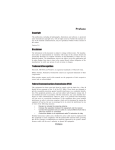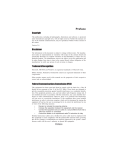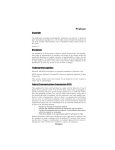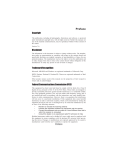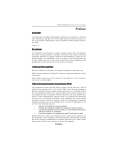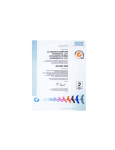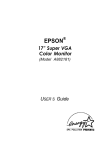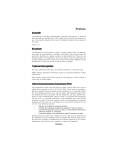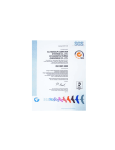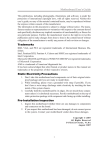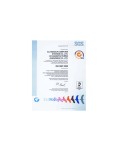Download ECS Motherboard P33T-A V1.0
Transcript
Preface Copyright This publication, including all photographs, illustrations and software, is protected under international copyright laws, with all rights reserved. Neither this manual, nor any of the material contained herein, may be reproduced without written consent of the author. Version 1.0 Disclaimer The information in this document is subject to change without notice. The manufacturer makes no representations or warranties with respect to the contents hereof and specifically disclaims any implied warranties of merchantability or fitness for any particular purpose. The manufacturer reserves the right to revise this publication and to make changes from time to time in the content hereof without obligation of the manufacturer to notify any person of such revision or changes. Trademark Recognition Microsoft, MS-DOS and Windows are registered trademarks of Microsoft Corp. MMX, Pentium, Pentium-II, Pentium-III, Celeron are registered trademarks of Intel Corporation. Other product names used in this manual are the properties of their respective owners and are acknowledged. Federal Communications Commission (FCC) This equipment has been tested and found to comply with the limits for a Class B digital device, pursuant to Part 15 of the FCC Rules. These limits are designed to provide reasonable protection against harmful interference in a residential installation. This equipment generates, uses, and can radiate radio frequency energy and, if not installed and used in accordance with the instructions, may cause harmful interference to radio communications. However, there is no guarantee that interference will not occur in a particular installation. If this equipment does cause harmful interference to radio or television reception, which can be determined by turning the equipment off and on, the user is encouraged to try to correct the interference by one or more of the following measures: • • • • Reorient or relocate the receiving antenna Increase the separation between the equipment and the receiver Connect the equipment onto an outlet on a circuit different from that to which the receiver is connected Consult the dealer or an experienced radio/TV technician for help Shielded interconnect cables and a shielded AC power cable must be employed with this equipment to ensure compliance with the pertinent RF emission limits governing this device. Changes or modifications not expressly approved by the system’s manufacturer could void the user’s authority to operate the equipment. Preface ii Declaration of Conformity This device complies with part 15 of the FCC rules. Operation is subject to the following conditions: • • This device may not cause harmful interference, and This device must accept any interference received, including interference that may cause undesired operation Canadian Department of Communications This class B digital apparatus meets all requirements of the Canadian Interferencecausing Equipment Regulations. Cet appareil numérique de la classe B respecte toutes les exigences du Réglement sur le matériel brouilieur du Canada. About the Manual The manual consists of the following: Describes features of the motherboard. Chapter 1 Introducing the Motherboard Go to H page 1 Describes installation of motherboard components. Chapter 2 Installing the Motherboard Go to H page 7 Provides information on using the BIOS Setup Utility. Chapter 3 Using BIOS Go to Chapter 4 Using the Motherboard Software page 27 Describes the motherboard software Go to Preface H H page 43 iii TABLE OF CONTENTS Preface i Chapter 1 1 Introducing the Motherboard 1 Introduction......................................................................................1 Feature...............................................................................................2 Motherboard Components.............................................................5 Chapter 2 7 Installing the Motherboard 7 Safety Precautions...........................................................................7 Choosing a Computer Case............................................................7 Installing the Motherboard in a Case............................................7 Checking Jumper Settings...............................................................8 Setting Jumpers...................................................................8 Checking Jumper Settings...................................................9 Jumper Settings...................................................................9 Installing Hardware........................................................................10 Installing the Processor.....................................................10 Installing Memory Modules...............................................12 Expansion Slots.................................................................15 Connecting Optional Devices............................................17 Installing a SATA Hard Drive...........................................20 Installing a Floppy Diskette Drive....................................21 Connecting I/O Devices................................................................22 Connecting Case Components.....................................................23 Front Panel Header...........................................................25 Chapter 3 27 Using BIOS 27 About the Setup Utility................................................................ 27 The Standard Configuration..............................................27 Entering the Setup Utility...................................................27 Using BIOS......................................................................................28 Standard CMOS Setup......................................................29 Advanced Setup.................................................................31 Advanced Chipset Setup....................................................33 iv Integrated Peripherals.......................................................34 Power Management Setup.................................................35 PCI/PnP Setup...................................................................36 PC Health Status...............................................................37 Frequency/Voltage Control...............................................39 Load Default Settings........................................................40 Supervisor Password........................................................40 User Password..................................................................41 Save & Exit Setup..............................................................41 Exit Without Saving............................................................41 Updating the BIOS.............................................................42 Chapter 4 43 Using the Motherboard Software 43 About the Software CD-ROM......................................................43 Auto-installing under Windows XP/Vista..................................43 Running Setup....................................................................44 Manual Installation........................................................................48 Utility Software Reference............................................................48 HDMI Audio Setting SOP.............................................................49 1 Chapter 1 Introducing the Motherboard Introduction Thank you for choosing the G45T-M2 motherboard. This motherboard is a high performance, enhanced function motherboard designed to support the LGA775 socket Intel® Yorkfield/Wolfdale/Core™ 2 Quad/Core™ 2 Duo/Pentium® Dual-Core (E21XX series)/Celeron® Dual-Core/Celeron® 4xx processors for high-end business or personal desktop markets. The motherboard incorporates the G45 Northbridge (NB) and ICH10 Southbridge (SB) chipsets. The Northbridge supports a Front Side Bus (FSB) frequency of 1333/ 1066/800 MHz using a scalable FSB Vcc_CPU. The memory controller supports DDR2 memory DIMM frequencies of 800/667. It supports four DDR2 Sockets with up to maximum memory of 16 GB. DDR2 Maximum memory bandwidth of 12.8 GB/ s in dual-channel symmetric mode assuming DDR2 800 MHz. High resolution graphics via one PCI Express slot, intended for Graphics Interface, is fully compliant to the PCI Express Base Specification revision 2.0. The ICH10 Southbridge supports two PCI slots which are PCI 2.3 compliant. In addition, one PCI Express x1 slot is supported. It implements an EHCI compliant interface that provides 480 Mb/s bandwidth for 12 USB 2.0 ports (4 USB ports and 4 USB 2.0 headers support additional 8 USB ports). The Southbridge integrates a Serial ATA host controller, supporting six SATA ports with maximum transfer rate up to 3.0 Gb/s each. The motherboard is equipped with advanced full set of I/O ports in the rear panel, including PS/2 mouse and keyboard connectors, one DVI port, one VGA port, four USB ports, one LAN port and audio jacks for microphone, line-in and 6/8-channel (optional) line-out. Introducing the Motherboard 2 Feature Processor The motherboard uses an LGA775 type of Intel® Yorkfield/Wolfdale/Core™ 2 Quad/Core™ 2 Duo/Pentium ® Dual-Core (E21XX series)/Celeron ® Dual-Core/ Celeron® 4xx processors that carries the following features: • • • Accommodates Intel® Yorkfield/Wolfdale/Core™ 2 Quad/Core™ 2 Duo/ Pentium® Dual-Core (E21XX series)/Celeron® Dual-Core/Celeron® 4xx processors Supports a system bus (FSB) of 1333/1066/800 MHz Supports “Hyper-Threading” technology CPU “Hyper-Threading” technology enables the operating system into thinking it’s hooked up to two processors, allowing two threads to be run in parallel, both on separate “logical” processors within the same physical processor. Chipset The G45 Northbridge (NB) and ICH10 Southbridge (SB) chipsets are based on an innovative and scalable architecture with proven reliability and performance. • G45 (NB) • • • • ICH10 (SB) • • • • • Supports 36-bit host bus addressing, allowing the CPU to access the entire 64 GB of the memory address space 2 GB/s point-to-point Direct Media Interface (DMI) to ICH10 (1 GB/s each direction) Supports 512-Mb, 1-Gb and 2-Gb DDR2 and 512-Mb and 1Gb DDR3 technologies for x8 and x16 devices One, 16-lane (x16) PCI Express port intended for supporting up to two external PCI Express graphics card in bifurcated mode, filly compatible to the PCI Express Base Specification revision 2.0 An integrated graphics device (IGD) delivering cost competitive 3D, 2D and video capabilities Enhanced DMA Controller, Timer/Counter functions, and Interrupt Controller Compliant with PCI Express Base Specification, Revision 1.1 Compliant with PCI 2.3 specification Integrated SATA 3.0 Gb/s Host Controller Integrated USB 2.0 Host Controller supporting up to twelve USB 2.0 ports Memory • • • Supports DDR2 800/667 DDR SDRAM with Dual-channel architecture Accommodates four unbuffered DIMMs Up to 4 GB per DIMM with maximum memory size up to 16 GB Introducing the Motherboard 3 Audio (optional) This motherboard may support either of the following Audio chipsets: • • • • • 7.1 + 2 channel High Definition Audio Codec All DACs Support 192k/96k/48k/44.1kHz DAC sample rate High-quality analog differential CD input Meets Microsoft WHQL/WLP 3.0 audio requirements Direct Sound 3DTM compatible • • • • • 7.1+2 channel High Definition Audio Codec All DACs Support 192k/96k/48k/44.1kHz DAC sample rate Software selectable 2.5V/3.75V VREFOUT Meets Microsoft WHQL/WLP 2.x audio requirements Direct Sound 3DTM compatible • • • 5.1 Channel High Definition Audio Codec ADCs support 44.1k/48k/96kHz sample rate Meets Microsoft WLP 3.08 Vista premium and mobile PCs audio requirements Direct Sound 3DTM compatible • Onboard LAN (optional) This motherboard may support either of the following LAN chipsets: • • • Integrated Fast Ethernet Controller for PCI ExpressTM Applications Integrated 10/100 transceiver Wake-on-LAN and remote wake-up support • • • Integrated Gigabit Ethernet Controller for PCI ExpressTM Applications Integrated 10/100/1000 transceiver Wake-on-LAN and remote wake-up support Expansion Options The motherboard comes with the following expansion options: • • • • One PCI Express x 16 slot for Graphic Interface One PCI Express x1 Slot Two 32-bit PCI v2.3 compliant slots Six 7-pin SATA connectors This motherboard supports Ultra DMA bus mastering with transfer rates of 133/ 100/66/33 Mb/s. Integrated I/O The motherboard has a full set of I/O ports and connectors: • Two PS/2 ports for mouse and keyboard • One DVI port • One VGA port • One Parallel port • Four USB ports • One LAN port • Audio jacks for microphone, line-in and 6/8-channel (optional) line-out Introducing the Motherboard 4 BIOS Firmware This motherboard uses AMI BIOS that enables users to configure many system features including the following: • Power management • Wake-up alarms • CPU parameters • CPU and memroy timing The firmware can also be used to set parameters for different processor clock speeds. 1. Some hardware specifications and software items are subject to change without prior notice. 2. Due to chipset limitation, we recommend that motherboard be operated in the ambiance between 0 and 50 °C. Introducing the Motherboard 5 Motherboard Components Table of Motherboard Components LABEL COMPONENTS LGA775 socket for Intel Yorkfield/Wolfdale/CoreTM 2 Quad/ ® 1. CPU Socket Core 2. CPU_FAN 3. DIMM1~4 4. FDD1 5. ATX_POWER1 6. SATA1~6 7. F_PANEL 8. F_USB1~4 9. CLR_CMOS 10. BIOS_WP 11. COM1 12. CD_IN 13. F_AUDIO 14. SPDIF_OUT 15. PCI1~2 16. PCIEX1 17. PCIE1 18. ATX12V1 19. SYS_FAN Celeron® Dual-Core/Celeron® 4xx series CPUs CPU cooling fan connector 240-pin DDR2 SDRAM slots Floppy disk drive connector Standard 24-pin ATX power connector Serial ATA connectors Front panel switch/LED header Front Panel USB headers Clear CMOS jumper BIOS flash protect header Onboard serial port header Analog audio input connector Front panel audio header SPDIF out header 32-bit add-on card slots PCI Express x1 slot PCI Express x16 graphics card slot 4-pin +12V power connector System cooling fan connector TM ® 2 Duo/Pentium Dual-Core (E21XX series)/ This concludes Chapter 1. The next chapter explains how to install the motherboard. Introducing the Motherboard 6 Memo Introducing the Motherboard 7 Chapter 2 Installing the Motherboard Safety Precautions • • • • • Follow these safety precautions when installing the motherboard Wear a grounding strap attached to a grounded device to avoid damage from static electricity Discharge static electricity by touching the metal case of a safely grounded object before working on the motherboard Leave components in the static-proof bags they came in Hold all circuit boards by the edges. Do not bend circuit boards Choosing a Computer Case There are many types of computer cases on the market. The motherboard complies with the specifications for the Micro ATX system case. First, some features on the motherboard are implemented by cabling connectors on the motherboard to indicators and switches on the system case. Make sure that your case supports all the features required. Secondly, this motherboard supports two enhanced IDE drives. Make sure that your case has sufficient power and space for all drives that you intend to install. Most cases have a choice of I/O templates in the rear panel. Make sure that the I/O template in the case matches the I/O ports installed on the rear edge of the motherboard. This motherboard carries a Micro ATX form factor of 244 x 244 mm. Choose a case that accommodates this form factor. Installing the Motherboard in a Case Refer to the following illustration and instructions for installing the motherboard in a case. Most system cases have mounting brackets installed in the case, which correspond the holes in the motherboard. Place the motherboard over the mounting brackets and secure the motherboard onto the mounting brackets with screws. Ensure that your case has an I/O template that supports the I/O ports and expansion slots on your motherboard. Installing the Motherboard 8 Do not over-tighten the screws as this can stress the motherboard. Checking Jumper Settings This section explains how to set jumpers for correct configuration of the motherboard. Setting Jumpers Use the motherboard jumpers to set system configuration options. Jumpers with more than one pin are numbered. When setting the jumpers, ensure that the jumper caps are placed on the correct pins. The illustrations show a 2-pin jumper. When the jumper cap is placed on both pins, the jumper is SHORT. If you remove the jumper cap, or place the jumper cap on just one pin, the jumper is OPEN. SHORT This illustration shows a 3-pin jumper. Pins 1 and 2 are SHORT. Installing the Motherboard OPEN 9 Checking Jumper Settings The following illustration shows the location of the motherboard jumpers. Pin 1 is labeled. Jumper Settings Jumper Type Description Setting (default) 1-2: NORMAL CLR_CMOS 3-pin BIOS_WP 2-pin CLEAR CMOS BIOS PROTECT 2-3: CLEAR 1 Before clearing the CMOS, make sure to turn off the CLR_CMOS system. OPEN: WRITE UNPROTECT SHORT: WRITE PROTECT 1 BIOS_WP To avoid the system instability after clearing CMOS, we recommend users to enter the main BIOS setting page to “Load Optimized Defaults” and then “Save & Exit Setup”. Installing the Motherboard 10 Installing Hardware Installing the Processor Caution: When installing a CPU heatsink and cooling fan make sure that you DO NOT scratch the motherboard or any of the surfacemount resistors with the clip of the cooling fan. If the clip of the cooling fan scrapes across the motherboard, you may cause serious damage to the motherboard or its components. On most motherboards, there are small surface-mount resistors near the processor socket, which may be damaged if the cooling fan is carelessly installed. Avoid using cooling fans with sharp edges on the fan casing and the clips. Also, install the cooling fan in a well-lit work area so that you can clearly see the motherboard and processor socket. Before installing the Processor This motherboard automatically determines the CPU clock frequency and system bus frequency for the processor. You may be able to change the settings in the system Setup Utility. We strongly recommend that you do not over-clock processors or other components to run faster than their rated speed. Warning: 1. Over-clocking components can adversely affect the reliability of the system and introduce errors into your system. Over-clocking can permanently damage the motherboard by generating excess heat in components that are run beyond the rated limits. 2. Always remove the AC power by unplugging the power cord from the power outlet before installing or removing the motherboard or other hardware components. This motherboard has an LGA775 socket. When choosing a processor, consider the performance requirements of the system. Performance is based on the processor design, the clock speed and system bus frequency of the processor, and the quantity of internal cache memory and external cache memory. Installing the Motherboard 11 CPU Installation Procedure The following illustration shows CPU installation components. A. Read and follow the instructions shown on the sticker on the CPU cap. B. Unload the cap · Use thumb & forefinger to hold the lifting tab of the cap. · Lift the cap up and remove the cap completely from the socket. C. Open the load plate · Use thumb & forefinger to hold the hook of the lever, pushing down and pulling aside unlock it. · Lift up the lever. · Use thumb to open the load plate. Be careful not to touch the contacts. D. Install the CPU on the socket · Orientate CPU package to the socket. Make sure you match triangle marker to pin 1 location. E. Close the load plate · Slightly push down the load plate onto the tongue side, and hook the lever. · CPU is locked completely. F. Apply thermal grease on top of the CPU. G. Fasten the cooling fan supporting base onto the CPU socket on the motherboard. H. Make sure the CPU fan is plugged to the CPU fan connector. Please refer to the CPU cooling fan user’s manual for more detail installation procedure. 1. To achieve better airflow rates and heat dissipation, we suggest that you use a high quality fan with 3800 rpm at least. CPU fan and heatsink installation procedures may vary with the type of CPU fan/heatsink sup plied. The form and size of fan/heatsink may also vary. 2. DO NOT remove the CPU cap from the socket before installing a CPU. 3. Return Material Authorization (RMA) requests will be accepted only if the motherboard comes with the cap on the LGA775 socket. Installing the Motherboard 12 Installing Memory Modules This motherboard accomodates four memory modules. It can support four 240-pin DDR2 800/667. The total memory capacity is 16 GB. DDR2 SDRAM memory module table Memory module Memory Bus DDR2 667 DDR2 800 333 MHz 400 MHz You must install at least one module in any of the four slots. Each module can be installed with 4 GB of memory; total memory capacity is 16 GB. The four DDR2 memory sockets (DIMM1, DIMM2, DIMM3, DIMM4) are divided into two channels and each channel has two memory sockets as following: ff Channel 0: DIMM1, DIMM2 ff Channel 1: DIMM3, DIMM4 Do not remove any memory module from its antistatic packaging until you are ready to install it on the motherboard. Handle the modules only by their edges. Do not touch the components or metal parts. Always wear a grounding strap when you handle the modules. Installation Procedure Refer to the following to install the memory modules. 1 2 3 4 5 6 This motherboard supports unbuffered DDR2 SDRAM . Push the latches on each side of the DIMM slot down. Align the memory module with the slot. The DIMM slots are keyed with notches and the DIMMs are keyed with cutouts so that they can only be installed correctly. Check that the cutouts on the DIMM module edge connector match the notches in the DIMM slot. Install the DIMM module into the slot and press it firmly down until it seats correctly. The slot latches are levered upwards and latch on to the edges of the DIMM. Install any remaining DIMM modules. Installing the Motherboard 13 Table A: DDR2 (memory module) QVL (Qualified Vendor List) The following DDR2 800/667 memory modules and combination have been tested and qualified for use with this motherboard. Type Size Vendor Infineon Ramaxel A-DATA A-DATA Apacer APOGEE CORSAIR CORSAIR CORSAIR GEIL Infinity 512 MB Micron PSC Ramaxel SAMSUNG SyncMAX TwinMOS TwinMOS Transcend DDR2 667 Transcend APACER APACER Apacer A-DATA APOGEE Infineon 1 GB Infineon Micron PSC PSC PSC Twinmos Aeneon Apacer Hynix 2 GB LeadMax PSC Qimonda A-DATA A-DATA Elpida (Kingston) 256 MB Infineon 512 MB DDR2 800 1 GB Infinity Kingston Kingston Kingston Micron Micron Sync MAX APACER APACER APACER Apacer A-DATA Aeneon CORSAIR CORSAIR Geil Hexon Infinity Module Name HYS64T325001HU-3-A HYB18T256 5NB31 D9DCG AD29608A88-3EG M2OAD5G3H3166I1C52 78.91G92.9K5 AU51082-667P005 Corsair K4T5108QC 64M8CFE PS1000545 VALUESELECT 32M8CEC GL2L64M088BA18W 0547W64M8 PC5300 MT4HTF6464AY-667E1 AL6E8E63J-6E1 5LB31 D9DCL K4T51083QC 04400WB01 R050008A TMM6208G8M30B 8D23JK-TT SEL520ZCE6 K4T51083QC JetRam J12Q3AB-6 Elpida 1GB AM4B5708GEWS7E-0637F AM4B5708GQJS7E0631F 78.01G9O.9K5 M2OAD5G3I4176I1C52 AU1G082-667P005 HYB18T512800BF3S Aeneon AET93E30RB-0650 1GB MT8HTF12864AY-667E1 AL7E8E63B-6E1T AL7E8F63J-6E1 AL7E8F73C-6E1 8D23KK-TT AET860UD00-30DB08X 78.A1G9O.9K4 HYMP125U64AP8-Y5-AB-A LeadMax LD5PS1G831 AL8E8F73C-6E1 HYS64T256020EU-3S- C2 AD29608A8A-25EG M2OAD6G3H3160I1E53 E5108AJBG-8E-E HYS64T64020HU-2.5-A HYB18T256 800AF25 04751208CZ5U2D KHX6400D2ULK2 KHX6400D2ULK2/1G KVR800D2N5/512 6WD22 D9GKX MT8HTF6464AY-80ED4 U538H8G090HL AM4B5708BPJS8E0634E AM4B5708JQJS8E0749D AM4B5808CQJS8E0749D 78.01GA0.9K5 VD29608A8D-25EG-E0722 AET760UD00-25DC08X CM2X1024-6400 CM2X1024-6400PRO GL2L64M088BA18H NP18T648512F-2.5 04701G16CZ5U2G Installing the Motherboard 14 Type Size 1 GB DDR2 800 2 GB Vendor Module Name NPC Kingston Kingston Ramaxel Samsung Transcend UMAX Aeneon Aeneon Apacer Apacer A-DATA CORSAIR Micron Micron PSC PSC Qimonda Qimonda Samsung NCPT7AUDR-25M48 KHX6400D2ULK2/2G KVR800D2N5/1G E5108AHSE-8E-E 0705098L1 ZCE7 K4T510830E TQ123PGF8T0709 U2S12D30TP-8E AET03R25DC 0732 AET860UD00-25DC08X AM4B5808CQJS8E 0747D 78.A1GA0.9K4 RED A-DATA M2OMI6H3J4720L1C5Z CM2X2048-6400C5 7QEIID9HNP MT16HTF25664AY-800E1 A3R1GE3CFF 734MAAOE AL8E8F73C-8E1 HYB18T1G800C2F-25F 0744 HYS64T256020EU-25F-C2 HCF7 K4T1G084QQ Installing the Motherboard 15 Expansion Slots Installing Add-on Cards The slots on this motherboard are designed to hold expansion cards and connect them to the system bus. Expansion slots are a means of adding or enhancing the motherboard’s features and capabilities. With these efficient facilities, you can increase the motherboard’s capabilities by adding hardware that performs tasks that are not part of the basic system. PCIE1 Slot The PCI Express x16 slot is used to install an external PCI Express graphics card that is fully compliant to the PCI Express Base Specification revision 2.0. PCIEX1 Slot The PCI Express x1 slots are fully compliant to the PCI Express Base Specification revision 1.1. PCI1~2 Slots This motherboard is equipped with two standard PCI slots. PCI stands for Peripheral Component Interconnect and is a bus standard for expansion cards, which for the most part, is a supplement of the older ISA bus standard. The PCI slots on this board are PCI v2.3 compliant. Before installing an add-on card, check the documentation for the card carefully. If the card is not Plug and Play, you may have to manually configure the card before installation. Installing the Motherboard 16 Follow these instructions to install an add-on card: 1 2 3 Remove a blanking plate from the system case corresponding to the slot you are going to use. Install the edge connector of the add-on card into the expansion slot. Ensure that the edge connector is correctly seated in the slot. Secure the metal bracket of the card to the system case with a screw. For some add-on cards, for example graphics adapters and network adapters, you have to install drivers and software before you can begin using the add-on card. Installing the Motherboard 17 Connecting Optional Devices Refer to the following for information on connecting the motherboard’s optional devices: F_AUDIO: Front Panel Audio header This header allows the user to install auxiliary front-oriented microphone and lineout ports for easier access. Pin Pin 1 3 5 7 9 Signal Name Signal Name PORT 1L 2 Signal Name Function AUD_GND PORT 1R 4 PRESENCE# PORT 2R 6 SENSE1_RETURN SENSE_SEND 8 10 SENSE2_RETURN PORT 2L Pin KEY SPDIF_OUT: SPDIF out header This is an optional header that provides an S/PDIF (Sony/Philips Digital Interface) output to digital multimedia device through optical fiber or coaxial connector. Pin 1 2 3 4 Signal Name +5VA Function 5V analog Power Key No pin SPDIF SPDIF digital output GND Ground Installing the Motherboard 18 CD_IN: Analog Audio Input connector Pin 1 2 3 4 Signal Name Function CD_L CD In left channel GND Ground GND CD_R Ground CD In right channel F_USB1~4: Front Panel USB headers The motherboard has four USB ports installed on the rear edge I/O port array. Additionally, some computer cases have USB ports at the front of the case. If you have this kind of case, use auxiliary USB connector to connect the front-mounted ports to the motherboard. Pin 1 2 3 4 5 6 7 8 9 10 Signal Name Function USBPWR Front Panel USB Power USBPWR Front Panel USB Power USB_FP_P0- USB Port 0 Negative Signal USB_FP_P1- USB Port 1 Negative Signal USB_FP_P0+ USB Port 0 Positive Signal USB_FP_P1+ USB Port 1 Positive Signal GND Ground GND Ground Key No pin NC Not connected Please make sure that the USB cable has the same pin assignment as indicated above. A different pin assignment may cause damage or system hang-up. SATA1~6: Serial ATA connectors These connectors are used to support the new Serial ATA devices for the highest date transfer rates (3.0 Gb/s), simpler disk drive cabling and easier PC assembly. It eliminates limitations of the current Parallel ATA interface. But maintains register compatibility and software compatibility with Parallel ATA. Pin 1 3 5 7 Signal Name Ground TXRXGround Pin 2 4 6 - Signal Name TX+ Ground RX+ - Installing the Motherboard 19 COM1: Onboard serial port header Connect a serial port extension bracket to this header to add a second serial port to your system. Pin 1 2 3 4 5 6 7 8 9 10 Signal Name DCDB SINB SOUTB Function Data Carrier Detect Serial Input UART B Serial Output DTRB UART B Data Terminal Ready GND Ground DSRB Data Set Ready RTSB CTSB RART B Request to Send Clear to Send RI Key Ring Indicator No pin Installing the Motherboard 20 Installing a SATA Hard Drive About SATA Connectors Your motherboard features six SATA connectors supporting a total of six drives. SATA refers to Serial ATA (Advanced Technology Attachment) is the standard interface for the IDE hard drives which are currently used in most PCs. These connectors are well designed and will only fit in one orientation. Locate the SATA connectors on the motherboard and follow the illustration below to install the SATA hard drives. Installing Serial ATA Hard Drives To install the Serial ATA (SATA) hard drives, use the SATA cable that supports the Serial ATA protocol. This SATA cable comes with an SATA power cable. You can connect either end of the SATA cable to the SATA hard drive or the connector on the motherboard. SATA cable (optional) SATA power cable (optional) Refer to the illustration below for proper installation: 1 2 3 Attach either cable end to the connector on the motherboard. Attach the other cable end to the SATA hard drive. Attach the SATA power cable to the SATA hard drive and connect the other end to the power supply. This motherboard supports the “Hot-Plug” function. Installing the Motherboard 21 Installing a Floppy Diskette Drive FDD1: Floppy Disk Connector Connect the single end of the floppy connector to the onboard floppy connector firstly, and then connect the remaining plugs on the other end to the floppy drives correspondingly. You must orient the cable connector so that the pin 1 (color) edge of the cable corresponds to the pin 1 of the I/O port connector. Installing the Motherboard 22 Connecting I/O Devices The backplane of the motherboard has the following I/O ports: PS2 Mouse Use the upper PS/2 port to connect a PS/2 pointing device. PS2 Keyboard Use the lower PS/2 port to connect a PS/2 keyboard. Parallel Port (LPT1) Use LPT to connect printers or other parallel communica (Optional) tions devices. DVI Port Use the DVI port to connect the monitor. VGA1 Port Connect your monitor to the VGA port. LAN Port Connect an RJ-45 jack to the LAN port to connect your computer to the Network. USB Ports Use the USB ports to connect USB devices. Audio Ports (Optional) Use the audio jacks to connect audio devices. The D port is for stereo line-in signal, while the F port is for microphone in signal. This motherboard supports 8-channel audio devices that correspond to the A, B, C, and E port respectively. In addition, all of the 3 ports, B, C, and E provide users with both right & left channels individually. Users please refer to the following note for specific port function definition. A: Center & Woofer B: Back Surround C: Side Surround D: Line-in E: Front Out F: Mic_in Rear The above port definition can be changed to audio input or audio output by changing the driver utility setting. Use the three audio ports to connect audio devices. The first jack is for stereo line-in signal. The second jack is for stereo line-out signal. The third jack is for microphone. Installing the Motherboard 23 Connecting Case Components After you have installed the motherboard into a case, you can begin connecting the motherboard components. Refer to the following: 1 2 3 4 5 Connect the CPU cooling fan cable to CPU_FAN. Connect the system cooling fan connector to SYS_FAN. Connect the case switches and indicator LEDs to the F_PANEL. Connect the standard power supply connector to ATX_POWER1. Connect the auxiliary case power supply connector to ATX12V1. Connecting 24-pin power cable The ATX 24-pin connector allows you to connect to ATX v2.x power supply. With ATX v2.x power supply, users please note that when installing 24-pin power cable, the latches of power cable and the ATX_POWER1 match perfectly. 24-pin power cable Connecting 4-pin power cable The ATX12V power connector is used to provide power to the CPU. When installing 4-pin power cable, the latches of power cable and the ATX12V1 match perfectly. 4-pin power cable Installing the Motherboard 24 CPU_FANS/SYS_FAN: FAN Power Connector Pin 1 2 3 4 Signal Name GND +12V Sense PWM Function System Ground Power +12V Sensor PWM Users please note that the fan connector supports the CPU cooling fan of 1.1A ~ 2.2A (26.4W max) at +12V. ATX_ POWER1: ATX 24-pin Power Connector Pin Signal Name 1 2 3 4 5 6 7 8 9 +3.3V 10 11 12 +12V Pin 13 14 15 16 17 18 19 20 21 +3.3V Ground +5V Ground +5V Ground PWRGD +5VSB 22 23 24 +12V +3.3V Signal Name +3.3V -12V Ground PS_ON Ground Ground Ground -5V +5V +5V +5V Ground ATX12V1: ATX 12V Power Connector Pin 1 2 3 4 Signal Name Ground Ground +12V +12V Installing the Motherboard 25 Front Panel Header The front panel header (F_PANEL) provides a standard set of switch and LED headers commonly found on ATX or Micro ATX cases. Refer to the table below for information: Pin Signal Function Pin 2 Signal Function 1 HD_LED_P Hard disk LED(+) FP PWR/SLP *MSG LED(+) 3 HD_LED_N Hard disk LED(- ) 4 FP PWR/SLP *MSG LED(-) 5 RST_SW_N Reset Switch(-) 6 PWR_SW_P Power Switch(+) 7 RST_SW_P Reset Switch(+) 8 PWR_SW_N Power Switch(-) 9 RSVD Reserved 10 Key No pin * MSG LED (dual color or single color) Hard Drive Activity LED Connecting pins 1 and 3 to a front panel mounted LED provides visual indication that data is being read from or written to the hard drive. For the LED to function properly, an IDE drive should be connected to the onboard IDE interface. The LED will also show activity for devices connected to the SCSI (hard drive activity LED) connector. Power/Sleep/Message waiting LED Connecting pins 2 and 4 to a single or dual-color, front panel mounted LED provides power on/off, sleep, and message waiting indication. Reset Switch Supporting the reset function requires connecting pin 5 and 7 to a momentarycontact switch that is normally open. When the switch is closed, the board resets and runs POST. Power Switch Supporting the power on/off function requires connecting pins 6 and 8 to a momentary-contact switch that is normally open. The switch should maintain contact for at least 50 ms to signal the power supply to switch on or off. The time requirement is due to internal de-bounce circuitry. After receiving a power on/off signal, at least two seconds elapses before the power supply recognizes another on/off signal. This concludes Chapter 2. The next chapter covers the BIOS. Installing the Motherboard 26 Memo Installing the Motherboard 27 Chapter 3 Using BIOS About the Setup Utility The computer uses the latest “American Megatrends Inc.” BIOS with support for Windows Plug and Play. The CMOS chip on the motherboard contains the ROM setup instructions for configuring the motherboard BIOS. The BIOS (Basic Input and Output System) Setup Utility displays the system’s configuration status and provides you with options to set system parameters. The parameters are stored in battery-backed-up CMOS RAM that saves this information when the power is turned off. When the system is turned back on, the system is configured with the values you stored in CMOS. The BIOS Setup Utility enables you to configure: • • • • Hard drives, diskette drives and peripherals Video display type and display options Password protection from unauthorized use Power Management features The settings made in the Setup Utility affect how the computer performs. Before using the Setup Utility, ensure that you understand the Setup Utility options. This chapter provides explanations for Setup Utility options. The Standard Configuration A standard configuration has already been set in the Setup Utility. However, we recommend that you read this chapter in case you need to make any changes in the future. This Setup Utility should be used: • • • • • when changing the system configuration when a configuration error is detected and you are prompted to make changes to the Setup Utility when trying to resolve IRQ conflicts when making changes to the Power Management configuration when changing the password or making other changes to the Security Setup Entering the Setup Utility When you power on the system, BIOS enters the Power-On Self Test (POST) routines. POST is a series of built-in diagnostics performed by the BIOS. After the POST routines are completed, the following message appears: Press DEL to enter SETUP Introducing the Motherboard 28 Press the delete key to access the BIOS Setup Utility. CMOS Setup Utility -- Copyright (C) 1985-2008, American Megatrends, Inc. f Standard CMOS Setup f Advanced Setup f Advanced Chipset Setup f Integrated Peripherals f Power Management Setup f PCI/PnP Setup f PC Health Status fFrequency/Voltage Control Load Default Settings fSupervisor Password fUser Password Save & Exit Setup Exit Without Saving mnlk : Move Enter : Select +/-/: Value F10: Save F1:General Help F9: Load Default Settings ESC: Exit v02.61 (C)Copyright 1985-2008, American Mega trends, Inc. Using BIOS When you start the Setup Utility, the main menu appears. The main menu of the Setup Utility displays a list of the options that are available. A highlight indicates which option is currently selected. Use the cursor arrow keys to move the highlight to other options. When an option is highlighted, execute the option by pressing <Enter>. Some options lead to pop-up dialog boxes that prompt you to verify that you wish to execute that option. Other options lead to dialog boxes that prompt you for information. Some options (marked with a triangle f) lead to submenus that enable you to change the values for the option. Use the cursor arrow keys to scroll through the items in the submenu. In this manual, default values are enclosed in parenthesis. Submenu items are denoted by a triangle f . The default BIOS setting for this motherboard applies for most conditions with optimum performance. It is not suggested to change the default values in the BIOS setup and the manufacture takes no responsibility to any damage caused by changing the BIOS settings. BIOS Navigation Keys The BIOS navigation keys are listed below: KEY ESC mnlk +/-/PU/PD FUNCTION Exits the current menu Scrolls through the items on a menu Modifies the selected field’s values Enter Select F9 Loads an optimized setting for better performance F10 Saves the current configuration and exits setup F1 Displays a screen that describes all key functions Introducing the Motherboard 29 For the purpose of better product maintenance, the manufacture reserves the right to change the BIOS items presented in this manual. The BIOS setup screens shown in this chapter are for reference only and may differ from the actual BIOS. Please visit the manufacture’s website for updated manual. Standard CMOS Setup This option displays basic information about your system. CMOS Setup Utility - Copyright (C) 1985-2008, American Megatrends, Inc. Standard CMOS Setup Date Time Alarm (hh:mm:ss) Wed 06/18/2008 00:01:55 f f f f f f Not Detected Hard Disk Not Detected Not Detected Not Detected Not Detected SATA1 SATA2 SATA3 SATA4 SATA5 SATA6 IDE BusMaster Enabled Drive A: 1.44 MB 31/2” Help Item User [Enter], [TAB] or [SHIFT-TAB] to select a field. Use [+] or [-] to configure system Date. mnlk: Move Enter : Select +/-/: Value F10: Save ESC: Exit F1: General Help F9: Load Default Settings Date & Time The Date and Time items show the current date and time on the computer. If you are running a Windows OS, these items are automatically updated whenever you make changes to the Windows Date and Time Properties utility. f SATA 1~6 Your computer has one IDE channel which can be installed with one or two devices (Master and Slave). In addition, this motherboard supports six SATA channels and each channel allows one SATA device to be installed. Use these items to configure each device on the IDE channel. CMOS SETUP UTILITY - Copyright (C) 1985-2008, American Megatrends, Inc. SATA1 Help Item SATA1 Device : Not Detected Type LBA/Large Mode Block (Multi-Sector Transfer PIO Mode DMA Mode S.M.A.R.T 32Bit Data Transfer Auto Auto Auto Auto Auto Auto Enabled Select the type of device connected to the system. mnlk: Move Enter : Select +/-/: Value F10: Save ESC: Exit F1: General Help F9: Load Default Settings Introducing the Motherboard 30 Type (Auto) Use this item to configure the type of the IDE device that you specify. If the feature is enabled, it will enhance hard disk performance by reading or writing more data during each transfer. LBA/Large Mode (Auto) Use this item to set the LAB/Large mode to enhance hard disk performance by optimizing the area the hard disk is visited each time. Block (Multi-Sector Transfer) (Auto) If the feature is enabled, it will enhance hard disk performance by reading or writing more data during each transfer. PIO Mode (Auto) Use this item to set the PIO mode to enhance hard disk performance by optimizing the hard disk timing. DMA Mode (Auto) DMA capability allows user to improve the transfer-speed and data-integrity for compatible IDE devices. S.M.A.R.T. (Auto) The S.M.A.R.T. (Self-Monitoring, Analysis and Reporting Technology) system is a diagnostics technology that monitors and predicts device performance. S.M.A.R.T. software resides on both the disk drive and the host computer. 32Bit Data Transfer (Enabled) Use this item to set the onboard SATA-IDE channel to be disabled, IDE, or RAID. Press <Esc> to return to the Standard CMOS Setup page. IDE BusMaster (Enabled) This item enables or disables the DMA under DOS mode. We recommend you to leave this item at the default value. Drive A (1.44 MB 31/2”) This item defines the characteristics of any diskette drive attached to the system. You can connect one or two diskette drives. Press <Esc> to return to the main menu setting page. Introducing the Motherboard 31 Advanced Setup This page sets up more advanced information about your system. Handle this page with caution. Any changes can affect the operation of your computer. CMOS Setup Utility - Copyright (C) 1985-2008, American Megatrends, Inc. Advanced Setup Thermal Management TM Status Limit CPUID MaxVal Enhanced Halt (C1E) Intel XD Bit Intel EIST Intel Virtualization Technol Quick Power on Self Test Boot Up Numlock Status APIC Mode 1st Boot Device 2nd Boot Device 3rd Boot Device f Hard Disk Drives fRemovable Drives Boot Other Device Enabled TM1/TM2 Disabled Enabled Enabled Enabled Enabled Enabled On Enabled Hard Disk Drive CD/DVD 1st FLOPPY DRIVE Press Enter Press Enter Yes Help Item For the processor its CPUTD belows 0F41h. TM2 only can be enable under below settings. 1.Freq.>=3.6GHz FSB800 2.Freq.>=2.8GHz FSB533 mnlk: Move Enter : Select +/-/: Value F10: Save ESC: Exit F1: General Help F9: Load Default Settings Thermal Management/TM Status (Enabled/TM1/TM2) These items display CPU’s temperature and enable you to set a safe temperature to Prescott CPU. Limit CPUID MaxVal (Disabled) This item can support Prescott CPUs for old OS. Users please note that under NT 4.0, it must be set “Enabled”, while under WinXP, it must be set “Disabled”. Enhanced Halt (C1E) (Enabled) This item enables or disables enhanced halt (C1E). Intel XD Bit (Enabled) This item allows users to enable or disable the Intel XD bit. Intel EIST (Enabled) This item allows users to enable or disable the EIST (Enhanced Intel SpeedStep technology. Intel Virtualization Technol (Enabled) Hardware Virtualization Technology enables processor feature for runningmultiple simultaneous Virtual Machines allowing specialized softwareapplications to run in full isolation of each other. Quick Power on Self Test (Enabled) Enable this item to shorten the power on testing (POST) and have your system start up faster. You might like to enable this item after you are confident that your system hardware is operating smoothly. Boot Up Numlock Status (On) This item defines if the keyboard Num Lock key is active when your system is started. Introducing the Motherboard 32 APIC Mode (Enabled) This item allows you to enable or disable the APCI (Advanced Programmable Interrupt Controller) mode. APIC provides symmetric multi-processing (SMP) for systems, allowing support for up to 60 processors. 1st/2nd/3rd Boot Device (Hard Disk Drive/CD/DVD/1st FLOPPY DRIVE) Use this item to determine the device order the computer used to look for an operating system to load at start-up time. The devices showed here will be different depending on the exact devices installed on your motherboard. fHard Disk Drives (Press Enter) Scroll to this item and press <Enter> to view the following screen: CMOS Setup Utility - Copyright (C) 1985-2008, American Megatrends, Inc. Hard Disk Drives Help Item Hard Disk Drives 1st Drive WDC WD1600JS-22NCB1 Specifies the boot sequence from the available devices. mnlk: Move Enter : Select +/-/: Value F10: Save ESC: Exit F1: General Help F9: Load Default Settings Press <Esc> to return to the Advanced Setup page. f Removable Drives (Press Enter) Scroll to this item and press <Enter> to view the following screen: CMOS Setup Utility - Copyright (C) 1985-2008, American Megatrends, Inc. Removable Drives Help Item Removable Drives 1st Drive 1st FLOPPY DRIVE Specifies the boot sequence from the available devices. mnlk: Move Enter : Select +/-/: Value F10: Save ESC: Exit F1: General Help F9: Load Default Settings Boot Other Device (Yes) When enabled, the system searches all other possible locations for an operating system if it fails to find one in the devices specified under the First, Second and Third boot devices. Press <Esc> to return to the main menu setting page. Introducing the Motherboard 33 Advanced Chipset Setup This page sets up more advanced information about your system. Handle this page with caution. Any changes can affect the operation of your computer. CMOS Setup Utility - Copyright (C) 1985-2008, American Megatrends, Inc. Advanced Chipset Setup DRAM Frequency Configure DRAM Timing by SPD IGD GTT Graphics smemory size IGD Graphics Mode Select DVMT Memory Memory Remap Feature HPET Auto Enabled No VT mode, 2MB Enabled, 64MB 256MB Enabled Enabled Help Item Options Auto 667 MHz 800 MHz mnlk: Move Enter : Select +/-/: Value F10: Save ESC: Exit F1: General Help F9: Load Default Settings DRAM Frequency (Auto) This item enables users to adjust the DRAM frequency. The default setting is auto and we recommend users leave the setting unchanged. Modify it at will may cause the system to be unstable. Configure DRAM Timing by SPD (Enabled) When this item is set to enable, the DDR timing is configured using SPD. SPD (Serial Presence Detect) is located on the memory modules, BIOS reads information coded in SPD during system boot up. IGD GTT Graphics memory size (No VT mode, 2MB) This item is used to select the amount of Main Memory that is pre-allocated to support the Internal Graphics Translation Table when IGD (Internal Graphics Device) is enabled. IGD Graphics Mode Select (Enabled, 64MB) This item is used to select the amount of Main Memory that is pre-allocated to support the Internal Graphics device in VGA (non-linear) and Native (linear) modes when Internal graphics is enabled. DVMT Memory (256MB) When set to Fixed Mode, the graphics driver will reserve a fixed portion of the system memory as graphics memory, according to system and graphics requirements. Memory Remap Feature (Enabled) This item allows you to remap the overlapped PCI memory above the total physical memory if you have a 64 bit OS and 8 GB of RAM. HPET (Enabled) This item enables or disables HPET (High Precision Event Timer) support. Press <Esc> to return to the main menu setting page. Introducing the Motherboard 34 Integrated Peripherals This page sets up some parameters for peripheral devices connected to the system. CMOS Setup Utility - Copyright (C) 1985-2008, American Megatrends, Inc. Integrated Peripherals Onboard SATA Mode Onboard LAN Function Onboard LAN Boot ROM Onboard AUDIO Function Serial Port1 Address Serial Port2 Address OnBoard CIR Port Parallel Port Address Parallel Port Mode Parallel Port IRQ USB Functions Legacy USB Support Enhanced Enabled Disabled Enabled 3F8&IRQ4 2F8/IRQ3 Disabled 378 Normal IRQ7 Enabled Enabled Help Item Options Disabled Compatible Enhanced mnlk: Move Enter : Select +/-/: Value F10: Save ESC: Exit F1: General Help F9: Load Default Settings Onboard SATA Mode (Enhanced) Use this item to select the mode of the Serial ATA. OnBoard LAN Function (Enabled) Use this item to enable or disable the onboard LAN function. OnBoard LAN Boot ROM (Disabled) Use this item to enable or disable the booting from the onboard LAN or a network add-in card with a remote boot ROM installed. OnBoard AUDIO Function (Enabled) Use this item to enable or disable the onboard Audio function. Serial Port1/2 Address (3F8/IRQ4 2F8/IRQ3) Use this item to enable or disable the onboard COM1/2 serial port, and to assign a port address. OnBoard CIR Port (Disabled) Use this item to enable or disable the OnBoard CIR Port. Parallel Port Address (378) Use this item to enable or disable the onboard Parallel port, and to assign a port address. Parallel Port Mode (Normal) Use this item to select the parallel port mode. You can select Normal (Standard Parallel Port), ECP (Extended Capabilities Port), EPP (Enhanced Parallel Port), or BPP (Bi-Directional Parallel Port). Introducing the Motherboard 35 Parallel Port IRQ (IRQ7) Use this item to assign IRQ to the parallel port. USB Functions (Enabled) Use this item to enable or disable the USB function. Legacy USB Support (Enabled) Use this item to enable or disable support for legacy USB devices. Setting to Auto allows the system to detect the presence of USB device at startup. If detected, the USB controller legacy mode is enabled. If no USB device is detected, the legacy USB support is disabled. Press <Esc> to return to the main menu setting page. Power Management Setup This page sets up some parameters for system power management operation. CMOS Setup Utility - Copyright (C) 1985-2008, American Megatrends, Inc. Power Management Setup ACPI Suspend Type Soft-off by PWR-BTTN PWRON After PWR-Fail Resume by Ring Resume by PCI/ PCI-E/Lan PME Resume by USB (S3) Resume By PS2 KB (S3) Resume By PS2 MS (S3) Resume on RTC Alarm S3 (STR) Instant Off Power Off Disabled Disabled Disabled Disabled Disabled Disabled Help Item Select the ACPI state used for System Suspend. mnlk: Move Enter : Select +/-/: Value F10: Save ESC: Exit F1: General Help F9: Load Default Settings ACPI Suspend Type (S3(STR)) Use this item to define how your system suspends. In the default, S3, the suspend mode is a suspend to RAM, i.e, the system shuts down with the exception of a refresh current to the system memory. Soft-Off By PWR-BTTN (Instant Off) Under ACPI (Advanced Configuration and Power management Interface) you can create a software power down. In a software power down, the system can be resumed by Wake Up Alarms. This item lets you install a software power down that is controlled by the power button on your system. If the item is set to Instant-Off, then the power button causes a software power down. If the item is set to Delay 4 Sec, then you have to hold the power button down for four seconds to cause a software power down. PWRON After PWR-Fail (Power Off) This item enables your computer to automatically restart or return to its operating status. Introducing the Motherboard 36 Resume by Ring (Disabled) An input signal on the serial Ring Indicator (RI) line (in other words, an incoming callon the modem) awakens the system from a soft off state. Resume by PCI/PCI-E/Lan PME (Disabled) These items specify whether the system will be awakened from power saving modeswhen activity or input signal of the specified hardware peripheral or component isdetected. Resume by USB (S3) (Disabled) This item allows users to enable or disable the USB device Walk-up from S3 mode. Resume By PS2 KB (S3) (Disabled) Use this item to allow keyboard activity to awaken the system from power saving mode. Resume By PS2 MS (S3) (Disabled) This item enables or disables you to allow mouse activity to awaken the system from power saving mode. Resume on RTC Alarm (Disabled) The system can be turned off with a software command. If you enable this item, the system can automatically resume at a fixed time based on the system’s RTC (realtime clock). Use the items below this one to set the date and time of the wake-up alarm. You must use an ATX power supply in order to use this feature. Press <Esc> to return to the main menu setting page. PCI / PnP Setup This page sets up some parameters for devices installed on the PCI bus and those utilizing the system plug and play capability. CMOS Setup Utility - Copyright (C) 1985-2008, American Megatrends, Inc. PCI / PnP Setup Init Display First Allocate IRQ to PCI VGA PCI Yes Help Item Select which graphics controller to use as the primary boot device. mnlk: Move Enter : Select +/-/: Value F10: Save ESC: Exit F1: General Help F9: Load Default Settings Init Display First (PCI) Use this item to select which graphics controller to use as the primary boot devices. Allocate IRQ to PCI VGA (Yes) If this item is enabled, an IRQ will be assigned to the PCI VGA graphics system. You set this value to No to free up an IRQ.vices. Press <Esc> to return to the main menu setting page. Introducing the Motherboard 37 PC Health Status On motherboards support hardware monitoring, this item lets you monitor the parameters for critical voltages, temperatures and fan speeds. CMOS Setup Utility - Copyright (C) 1985-2008, American Megatrends, Inc. PC Health Status Help Item -=- System Hardware Monitor-=f Smart Fan Function CPU Temperature System Temperature CPU FAN Speed SYS FAN Speed PWR FAN Speed CPU Core VDIMM Press Enter :47°C/116°F : 22°C/71° F : 3479 RPM : N/A : N/A :1.296V : 1.824V Warning Temperature Shutdown Temperature Disabled Disabled mnlk: Move Enter : Select +/-/: Value F10: Save ESC: Exit F1: General Help F9: Load Default Settings f Smart Fan Function Scroll to this item and press <Enter> to view the following screen: CMOS Setup Utility - Copyright (C) 1985-2008, American Megatrends, Inc. Smart Fan Function CPU SMART FAN Control SMART Fan start PWM value SMART Fan start PWM TEMP (°C) DeltaT SMART Fan Slope PWM value CPU Fan Full Limit Temp. (°C) Enabled 50 50 +3 4 PWM value/°C 69°C Help Item Options Disabled Enabled mnlk: Move Enter : Select +/-/: Value F10: Save ESC: Exit F1: General Help F9: Load Default Settings CPU SMART FAN Control (Enabled) This item enables you to define the CPU temperature by smartly adjusting the CPU fan. When it is set at certain temperature, the CPU Fan PWM value will change accordingly. SMART Fan start PWM value (50) This item is used to set the start PWM value of the smart fan. SMART Fan start PWM TEMP (°C) (50) This item is used to set the start temperature of the smart fan. Introducing the Motherboard 38 DeltaT (+3) This item specifies the range that controls CPU temperature and keeps it from going so high or so low when smart fan works. SMART Fan Slope PWM value (4 PWM value/°C) This item is used to set the Slope Select PWM of the smart fan. CPU Fan Full Limit Temp. (°C) (69°C) This item is used to set the limit temperature of the smart fan. ECS supports the latest PECI host technology. While using Wolfdale or Yorkfield CPU, the original images of the BIOS item “PC Health Status” and “Smart FAN Function” will be replaced by PECI mode and negative number. (The max data from PECI is zero.) CMOS Setup Utility - Copyright (C) 1985-2008, American Megatrends, Inc. PC Health Status Help Item -=- System Hardware Monitor-=- f Smart Fan Function System Temperature CPU FAN Speed SYS FAN Speed PWR FAN Speed CPU Core VDIMM Press Enter : 22°C/71°F : 3571 RPM : N/A : N/A : 1.104V : 1.824V -=- PECI Mode-=Offset to TCC Activation Temp.: -81 mnlk: Move Enter : Select +/-/: Value F10: Save ESC: Exit F1: General Help F9: Load Default Settings CMOS Setup Utility - Copyright (C) 1985-2008, American Megatrends, Inc. Smart Fan Function CPU SMART FAN Control SMART Fan start PWM value SMART Fan start PWM TEMP (-) DeltaT SMART Fan Slope PWM value CPU Fan Full Speed Offset (-) Enabled 28 30 +3 5 10 Help Item Options Disabled Enabled mnlk: Move Enter : Select +/-/: Value F10: Save ESC: Exit F1: General Help F9: Load Default Settings Press <Esc> to return to the PC Health Status page. Introducing the Motherboard 39 System Component Characteristics These items display the monitoring of the overall inboard hardware health events, such as System & CPU temperature, CPU & DIMM voltage, CPU & system fan speed,...etc. • • • • CPU/System Temperature CPU/SYS FAN Speed CPU Core VDIMM Warning Temperature (Disabled) This item lets you select the temperature at which you want the system to send out a warning message to the PC speakers when the temperature goes beyond either limit. You can select the temperatures you want. Shutdown Temperature (Disabled) Enable you to set the maximum temperature the system can reach before powering down. Press <Esc> to return to the main menu setting page. Frequency/Voltage Control This page enables you to set the clock speed and system bus for your system. The clock speed and system bus are determined by the kind of processor you have installed in your system. CMOS Setup Utility - Copyright (C) 1985-2008, American Megatrends, Inc. Frequency/Voltage Control Manufacturer : Intel Ratio Actual Value: 8 CPU Frequency Setting : CPU Over-clocking Func.: Auto Detect DIMM/PCI CIK Spread Spectrum Memory Voltage Ratio Setting Help item 333MHz Disabled Enabled Enabled Normal 0.670 Options Disabled Enabled mnlk: Move Enter : Select +/-/: Value F10: Save ESC: Exit F1: General Help F9: Load Default Settings Manufacturer (Intel) This item displays the information of current manufacturer of the CPU installed in your computor. Ratio Actual Value (8) This item shows the actual ratio of the CPU installed in your System. CPU Frequency Setting (333MHz) This item indicates the current CPU frequency. Users can not make any change to this item. Please noted that the frequency will be varied with different CPU. Introducing the Motherboard 40 CPU Over-clocking Func. (Disabled) This item decides the CPU over-clocking function/frequencyinstalled in your system. If the over-clocking fails, please turn offthe system power. And then, hold the PageUp key (similar to theClear CMOS function) and turn on the power, the BIOS willrecover the safe default. Auto Detect DIMM/PCI Clk (Enabled) When this item is enabled, BIOS will disable the clock signal of free DIMM/PCI slots. Spread Spectrum (Enabled) If you enable spread spectrum, it can significantly reduce the EMI (Electro-Magnetic Interference) generated by the system. Memory Voltage (Normal) This item allows users to adjust the DDR memory voltage. Ratio Setting (0.670) Use this item to set the ratio of the CPU installed in your System. Press <Esc> to return to the main menu setting page. Load Default Settings This option opens a dialog box to ask if you are sure to install optimized defaults or not. You select [OK], and then <Enter>, the Setup Utility loads all default values; or select [Cancel], and then <Enter>, the Setup Utility does not load default values. Supervisor Password This page helps you install or change a password. CMOS Setup Utility - Copyright (C) 1985-2008, American Megatrends, Inc. Supervisor Password Supervisor Password Help item :Not Installed Change Supervisor Password Press Enter Install or Change the password. mnlk: Move Enter : Select +/-/: Value F10: Save ESC: Exit F1: General Help F9: Load Default Settings Supervisor Password (Not Installed) This item indicates whether a supervisor password has been set. If the password has been installed, Installed displays. If not, Not Installed displays. Change Supervisor Password (Press Enter) You can select this option and press <Enter> to access the sub menu. You can use the sub menu to change the supervisor password. Press <Esc> to return to the main menu setting page. Introducing the Motherboard 41 User Password This page helps you install or change a password. CMOS Setup Utility - Copyright (C) 1985-2008, American Megatrends, Inc. User Password User Password : Not Installed Change User Password Help item Press Enter Install or Change the password. mnlk: Move Enter : Select +/-/: Value F10: Save ESC: Exit F1: General Help F9: Load Default Settings User Password (Not Installed) This item indicates whether a user password has been set. If the password has been installed, Installed displays. If not, Not Installed displays. Change User Password (Press Enter) You can select this option and press <Enter> to access the sub menu. You can use the sub menu to change the user password. Press <Esc> to return to the main menu setting page. Save & Exit Setup Highlight this item and press <Enter> to save the changes that you have made in the Setup Utility and exit the Setup Utility. When the Save and Exit dialog box appears, select [OK] to save and exit, or select [Cancel] to return to the main menu. Exit Without Saving Highlight this item and press <Enter> to discard any changes that you have made in the Setup Utility and exit the Setup Utility. When the Exit Without Saving dialog box appears, select [OK] to discard changes and exit, or select [Cancel] to return to the main menu. If you have made settings that you do not want to save, use the “Exit Without Saving” item and select [OK] to discard any changes you have made. Introducing the Motherboard 42 Updating the BIOS You can download and install updated BIOS for this motherboard from the manufacturer’s Web site. New BIOS provides support for new peripherals, improvements in performance, or fixes for known bugs. Install new BIOS as follows: 1 2 3 4 5 6 7 If your motherboard has a BIOS protection jumper, change the setting to allow BIOS flashing. If your motherboard has an item called Firmware Write Protect in Advanced BIOS features, disable it. (Firmware Write Protect prevents BIOS from being overwritten.) Prepare a bootable device or create a bootable system disk. (Refer to Windows online help for information on creating a bootable system disk.) Download the Flash Utility and new BIOS file from the manufacturer’s Web site. Copy these files to the bootable device. Turn off your computer and insert the bootable device in your computer. (You might need to run the Setup Utility and change the the boot priority items on the Advanced BIOS Features Setup page, to force your computer to boot from the bootable device first.) At the C:\ or A:\ prompt, type the Flash Utility program name and the file name of the new BIOS and then press <Enter>. Example: AMINF340.EXE040706.ROM When the installation is complete, remove the bootable device from the computer and restart your computer. If your motherboard has a Flash BIOS jumper, reset the jumper to protect the newly installed BIOS from being overwritten. The computer will restart automatically. This concludes Chapter 3. Refer to the next chapter for information on the software supplied with the motherboard. Introducing the Motherboard 43 Chapter 4 Using the Motherboard Software About the Software CD-ROM The support software CD-ROM that is included in the motherboard package contains all the drivers and utility programs needed to properly run the bundled products. Below you can find a brief description of each software program, and the location for your motherboard version. More information on some programs is available in a README file, located in the same directory as the software. Before installing any software, always inspect the folder for files named README.TXT, INSTALL.TXT, or something similar. These files may contain important information that is not included in this manual. 1. Never try to install all software from folder that is not specified for use with your motherboard. 2. The notice of Intel HD audio installation (optional): The Intel High Definition audio functionality unexpectedly quits working in Windows Server 2003 Service Pack 1 or Windows XP Professional x64 Edition. Users need to download and install the update packages from the Microsoft Download Center “before” installing HD audio driver bundled in the Driver CD. Please log on to http://support.microsoft.com/default.aspx?scid=kb;enus;901105#appliesto for more information. Auto-installing under Windows XP/Vista The Auto-install CD-ROM makes it easy for you to install the drivers and software for your motherboard. If the Auto-install CD-ROM does not work on your system, you can still install drivers through the file manager for your OS (for example, Windows Explorer). Refer to the Utility Folder Installation Notes later in this chapter. The support software CD-ROM disc loads automatically under Windows XP/Vista. When you insert the CD-ROM disc in the CD-ROM drive, the autorun feature will automatically bring up the install screen. The screen has three buttons on it, Setup, Browse CD and Exit. If the opening screen does not appear; double-click the file “setup.exe” in the root directory. Using the Motherboard Software 44 Setup Tab Setup Click the Setup button to run the software installation program. Select from the menu which software you want to install. Browse CD The Browse CD button is the standard Windows command that allows you to open Windows Explorer and show the contents of the support CD. Before installing the software from Windows Explorer, look for a file named README.TXT, INSTALL.TXT or something similar. This file may contain important information to help you install the software correctly. Some software is installed in separate folders for different operating systems. In installing the software, execute a file named SETUP.EXE or INSTALL.EXE by double-clicking the file and then following the instructions on the screen. Exit The EXIT button closes the Auto Setup window. Application Tab Lists the software utilities that are available on the CD. Read Me Tab Displays the path for all software and drivers available on the CD. Running Setup Follow these instructions to install device drivers and software for the motherboard: 1. Click Setup. The installation program begins: The following screens are examples only. The screens and driver lists will be different according to the motherboard you are installing. The motherboard identification is located in the upper left-hand corner. Using the Motherboard Software 45 2. Click Next. The following screen appears: 3. Check the box next to the items you want to install. The default options are recommended. 4. Click Next run the Installation Wizard. An item installation screen appears: 5. Follow the instructions on the screen to install the items. 1. Drivers and software are automatically installed in sequence. Follow the onscreen instructions, confirm commands and allow the computer to restart a few times to complete the installation. 2. During the Windows Vista Driver Auto Setup Procedure, users should use one of the following two methods to install the driver after the system restart. Using the Motherboard Software 46 Method 1. Run Reboot Setup Windows Vista will block startup programs by default when installing drivers after the system restart. You must select taskbar icon Run Blocked Program and run Reboot Setup to install the next driver, until you finish all drivers installation. Method 2. Disable UAC (User Account Control) * For administrator account only. Standard user account can only use Method 1. Disable Vista UAC function before installing drivers, then use CD driver to install drivers, it will continue to install drivers after system restart without running blocked programs. Follow these instructions to Disable Vista UAC function: 1. Go to Control Panel. Using the Motherboard Software 47 2. Select Classic View. 3. Set User Account. 4. Select Turn User Account Control on or off and press Continue. Using the Motherboard Software 48 5. Disable User Account Control (UAC) to help protect your computer item and press OK, then press Restart Now. Then you can restart your computer and continue to install drivers without running blocked programs. Manual Installation Insert the CD in the CD-ROM drive and locate the PATH.DOC file in the root directory. This file contains the information needed to locate the drivers for your motherboard. Look for the chipset and motherboard model; then browse to the directory and path to begin installing the drivers. Most drivers have a setup program (SETUP.EXE) that automatically detects your operating system before installation. Other drivers have the setup program located in the operating system subfolder. If the driver you want to install does not have a setup program, browse to the operating system subfolder and locate the readme text file (README.TXT or README.DOC) for information on installing the driver or software for your operating system. Utility Software Reference All the utility software available from this page is Windows compliant. They are provided only for the convenience of the customer. The following software is furnished under license and may only be used or copied in accordance with the terms of the license. These software(s) are subject to change at anytime without prior no tice. Please refer to the support CD for available software. Using the Motherboard Software 49 HDMI Audio Setting SOP OS: XP system 1. Control Panel-->Sound and Audio Device Properties 2. a. Audio--> Sound playback--> Default device--> HD Auido Output b. Audio--> Sound playback--> Default device--> HDMI Auido Output 3. a. User Playback Audio speaker function working b. User Playback HDMI speaker function working Using the Motherboard Software 50 OS: Vista system Control Panel--> Soundback--> Sound--> Digital Output Device (HDMI) --> Set Default 1. Volume --> Playback 2. Digital Output Device (HDMI) --> Set Default --> OK User HDMI Playback function working Using the Motherboard Software 51 3. Speaker --> Set Default --> OK User Speaker Palyback function working 4. SPDIF-Out --> Set Default --> OK User SPDIF-Out Playback function working This concludes chapter 4. Using the Motherboard Software 52 Memo Using the Motherboard Software


























































